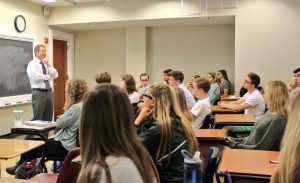Dr. Andrew Nobel received NSF collaboration grant on “Random dynamical systems and limit theorems for optimal tracking”
Dr. Andrew Nobel received NSF collaboration grant on “Random dynamical systems and limit theorems for optimal tracking”
February 15, 2017
The proposed research investigates the structure of families of dynamical systems from two complementary points of view. The first point of view is the “forward problem,” in which one chooses a system at random from an ensemble of systems and describes its properties with high probability. The second point of view is the ”inverse problem,” in which one makes observations from an unknown system within a known family and attempts to recover some information about the unknown system from the observations. The research has three primary aims.
Aim 1: To describe the likely structural properties of dynamical systems that evolve according to randomly chosen rules.
Aim 2: To establish a rigorous theoretical foundation for the analysis of optimization problems and related statistical inference methodology for dynamical systems.
Aim 3: To develop a relative version of the thermodynamic formalism and investigate its connections to Bayesian inference.
Authors/roles: Kevin McGoff (PI), Sayan Mukherjee and Andrew Nobel (co-PIs)



